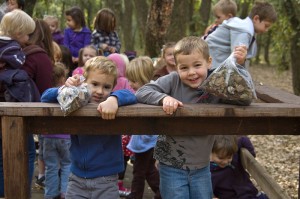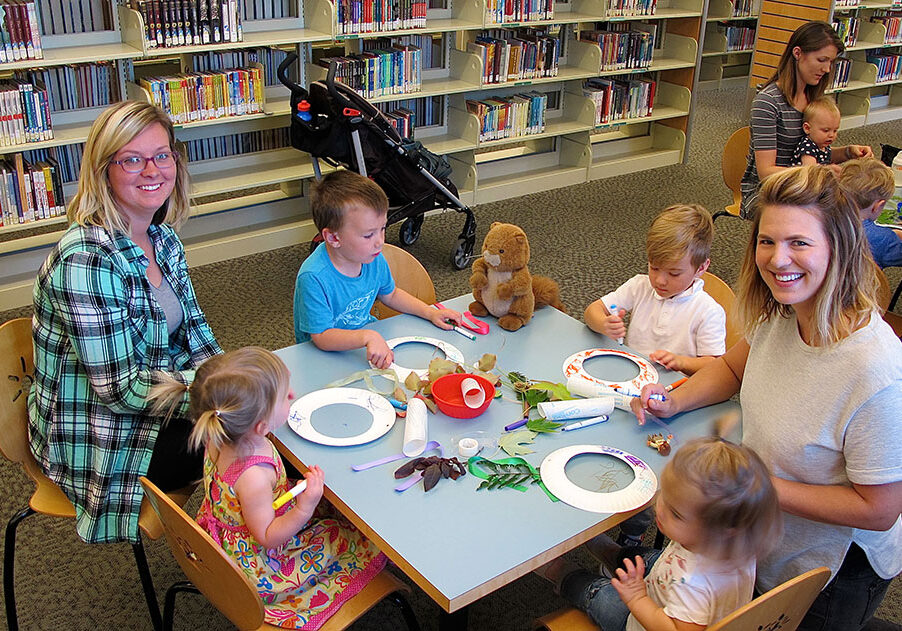
Children from Chico Montessori Children’s House enjoy a nature hike in the park.
A revolutionary idea was brought to the United States in 1915 by Dr. Maria Montessori, who said that a classroom can be set up to recognize each child’s developmental rhythm. Today, private, public and charter Montessori schools offer an alternative to the one-size-fits-all traditional classroom, where children take the lead and use the world around them as their learning tool.
Maria Montessori’s model for the U.S. was the first Casa de Bambini, or Children’s House, that she opened in the slums of Rome, Italy in 1907. There she found that underprivileged and institutionalized children were proud to have the opportunity to care for themselves by doing everyday tasks like sewing buttons on their clothes, tying their shoes, cooking and sweeping. These were practical skills that helped self-esteem and learning.
[sws_pullquote_right] “The secret of all nature is to be found in the soul of a child.” –Maria Montessori [/sws_pullquote_right] Today, Montessori’s legacy continues at the Chico Montessori Children’s House and the Montessori Children’s House of Shady Oaks in Redding. Three-year-olds pour rice from cup to cup to develop their fine motor skills; 4-year-olds are sweeping the floor and 5-year-olds are watering plants as they develop their large-motor movement. These practical life skills are still the cornerstone of early Montessori education.
The Montessori classroom is a prepared environment that takes into consideration Maria Montessori’s studies on how children have “absorbent minds” and have sensitive periods when, developmentally, they are better able to learn. Hands-on learning materials are used which allow children to choose an activity and work independently as they develop physically, mentally and spiritually.
According to Charlotte Rainwater, Director of the Chico Montessori Children’s House, observation and patience are paramount. When young Montessori children are involved in an activity, they get into a focused learning space and don’t like to be interrupted until the task is complete. “Allowing children time to explore and learn gives them individual power and self-esteem. The process of development and learning can be slow between 3 and 6 years old, and unfortunately, patience is not always one of the watch words in our society,” states Rainwater.
Montessori children learn from the concrete to the abstract. Concrete materials are presented to them first, through manipulative materials or games, before the concept is attempted “on paper,” or in the abstract. Sometimes materials need to be presented several times before the concept is grasped. The child’s developmental level is always honored.

Middle Creek Montessori students explore and learn.
Montessori teachers agree that manipulative materials used in the classroom create a memory that stays with a child forever. They are colorful and practical. For example, many Montessori alumni have the visual memory of the brightly colored puzzle map, the feel of the 1000-unit cube, or counting golden beads during math work. These tools provide tangible and lasting ways to learn.
Michelle Yezbick, Director of Chico’s Sherwood Montessori, emphasizes that concrete to abstract learning begins in the Children’s Houses and continues through all age levels. Many of the same materials are used through the grade levels, but the tasks will change as the developmental abilities of the child changes.
For example a 3-year-old will stack the blocks from the Montessori Pink Tower, a set of ten solid wooden cubes painted light pink, as a simple exercise of eye-hand coordination. A fourth grader will use the same pink blocks as a problem-solving lesson when learning about volume. Yezbick explains how the fourth grader’s memory and familiarity with the Pink Tower eases the mental burden of learning a new concept.
Montessori’s multiage class groupings of 6- to 9-year-olds and 9- to 12-year-olds provide opportunity for mentoring and “children teaching children.” Moira Casey, Principal of Shasta Union Elementary School’s Middle Creek Montessori finds that Montessori recognizes the variables of development and allows the child to take the lead.
“The multiage grouping of Montessori offers latitude that can accommodate all skill levels, especially in math,” says Casey. For instance, a first grader at her school has poor reading skills, yet can do long division. Montessori allows this student to follow his interest and skill level.
Yezbick says the Montessori classroom is often referred to as the “20-ring circus.” At any given time, children are working on math, reading, art, geography, practical life activities or having a snack, at the same time.” This environment encourages choice, self-direction and independence.
Yezbick acknowledges that in the public school classroom there is more differentiation than there used to be, but usually the whole class is working on the same curriculum topic at the same time. Both Yezbick and Casey emphasize that the Montessori method is not teacher driven. The child “owns it” and masters it.
When choosing a Montessori school, it is advised to go on a tour and choose a school with trained Montessori teachers. All public and charter programs are required to do testing according to the state standards. Montessori recognizes that children develop at different rates, so meeting state benchmarks can be challenging. According to Casey, “Testing is a challenge for everyone in education.”
After almost 100 years, Maria Montessori’s method continues to prevail through the challenges of twenty-first century education by putting the child first.
[sws_blue_box box_size=”593″]
North State Montessori Schools
Chico Montessori Children’s House (Private)
Ages 3 to 5
814 Glenn St., Chico
530-342-5518
Montessori Children’s House of Shady Oaks (Private)
Ages 2 to 5
1410 Victor Ave., Redding
530-222-0355
Middle Creek Montessori at Shasta Union Elementary (Public)
Ages 6 to 9 and 9 to 12
10446 Red Bluff Rd., Shasta
530-243-1110
Sherwood Montessori (Charter)
Ages 6 to 9, 9 to 12, and Middle School
746 Moss Ave., Chico
530-345-6600
Sunny Garden Montessori Play Space (Parent Participation)
Ages 0 to 3, M-F 9:00-10:30
Ages 1 to 5, M-F 10:30-12:30
2801 Godman Ave., Chico
530-343-3101
Montessori Resources
- American Montessori Society www.amshq.org
- Association of Montessori International www.montessori-ami.org
- The Montessori Project http://www.themontessoriproject.com [/sws_blue_box]
Posted in: Education
Comment Policy: All viewpoints are welcome, but comments should remain relevant. Personal attacks, profanity, and aggressive behavior are not allowed. No spam, advertising, or promoting of products/services. Please, only use your real name and limit the amount of links submitted in your comment.
You Might Also Like...

Getting All the Buzz on Bees at Orland’s Honeybee Discovery Center
Because one-third of all the food we eat is directly or indirectly dependent on honeybee pollination, bees and other pollinators are vital for human life. At Orland’s Honeybee Discovery Center, […]

Your Local Library is a Hub of Activity
If a library isn’t your idea of the “happening place” in town, it’s time to walk back through the doors of your local branch. Gayle Harrington, Cottonwood’s director of library […]
Mi Escuelita Maya Preschool & Children’s Performing Arts Program – A Place of Learning and Inspiration
In a setting best described as welcoming and warm, where diversity is honored and creativity abounds, children go about the business of learning with great enthusiasm. Smiling teachers clearly are […]

Wild Things at Your Child’s School
A nonprofit animal rescue Your classmates may have been wild, but if you grew up in the North State, you probably made it through your entire academic career without so […]



